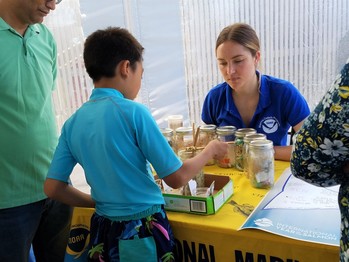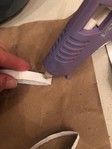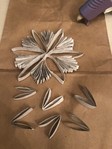 Access educational resources on the NOAA Marine Debris Program website.
Talking Trash and Taking Action was developed as a means to educate the next generation about ocean trash and, most importantly, how we all can prevent it. Created through an educational partnership between the Ocean Conservancy and the NOAA Marine Debris Program, this flexible curriculum can be adapted for all ages.
Check out the lesson, Matching Trash (page 12), where participants will learn the different material that marine debris is comprised of by grouping different types of debris together.
Download the full lesson plan here.
Download the Debris Deck here.
 The Marine Debris Program’s Northeast Regional Coordinator, Demi Fox, applies STEM techniques at the New England Aquarium's World Ocean Day (Photo: NOAA).
At the NOAA Marine Debris Program (MDP), we are often asked, “What can we do to help clean up the ocean?” Prevention is key to solving the marine debris problem over time. If you think about an overflowing sink, the first step before cleaning up the water is to turn off the tap. However, in order to prevent marine debris, we need to understand where it is coming from and that understanding starts with a solid marine debris educational foundation.
View the blog to learn how MDP matched a lesson plan to each STEAM category.
Make your own snow day with this simple snowflake craft (Photo: NOAA).
Create snowflakes from paper tubes and paint.
Supplies needed:
-Paper tubes (4 toilet paper tubes or 2 paper towel tubes will make one snowflake as shown above).
-Scissors
-White paint
-Yarn
-Hot glue gun (*Glue guns become very hot. Handle the glue gun and hot glue with care.)
Directions:
 |
|
1. Paint the outside of the paper tube white (or any color) and set aside to dry. |
 |
|
2. Press the paper tube flat and cut the tube into small circles. |
 |
|
3. Lay out the pieces into the shape of a snowflake. Snowflake patterns will vary. Feel free to design your own snowflake style. |
 |
|
4. Using the hot glue gun, begin to glue the pieces together. You may have to pinch the location where glue was just applied to ensure that they "stick" together. Glue as many paper pieces together as desired to make the snowflake. |
 |
|
5. To make shorter sections, fold the cut tube in half. Once the flake is completed, allow several minutes for it to dry. |
 |
|
6. Once the snowflake is dry, thread a piece of yarn trough one of the loops. Hang it up as desired. |
Let us know what you think!
Please provide feedback on our marine debris resources so that we can better serve your needs.
Email: marinedebris.education@noaa.gov
|